BRAZIL
Plants and Animals

Plants and Animals

Cities in BRAZIL
| Rio de janeiro |
Plants and Animals
Plants
The Amazon region is the Mecca for plant and animal lovers. About half of the 5 million species of plants and animals that exist in the world are found in this area. In addition, there are thousands of animal and plant species that have not even been discovered.
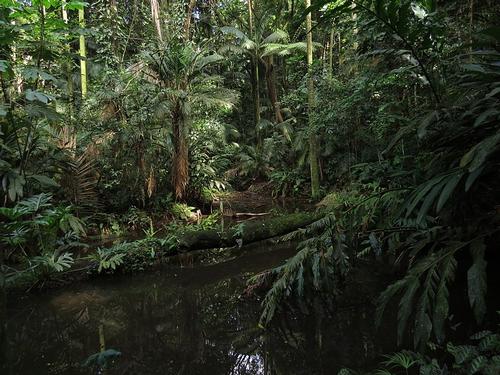 Selva de BrazilPhoto: Isabelle Allet-Coche CC 4.0 International no changes
Selva de BrazilPhoto: Isabelle Allet-Coche CC 4.0 International no changes
The Amazon region consists almost entirely of tropical rainforest, also called "selva", and is characterized by an enormous diversity of species. The trees are covered with many vines, mosses, orchids, ferns and epiphytes or host plants. Epiphytes are non-parasitic tree-living plants. These trees keep their green canopy all year round. Some well-known tree species include the Bertholletia, which produces tasty Brazil nuts and the rubber tree. Other varieties are myrtles, a type of shrub, laurel, palm, rubber tree, kapok tree, rose tree and fig tree.
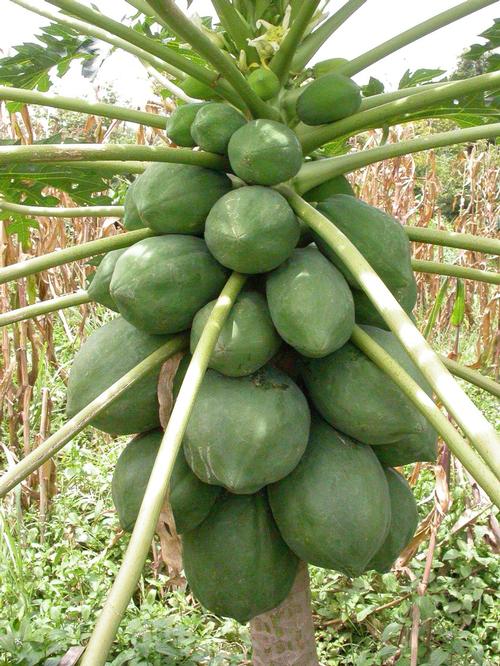 Papaya BrazilPhoto: Marco Schmidt CC 2.5 Generic no changes made
Papaya BrazilPhoto: Marco Schmidt CC 2.5 Generic no changes made
Fruit trees include papaya, guava and banana tree. Popular Philodendrons grow here in the wild. Very special is the giant water lily, the "Vitória regia". Due to lack of light, there is relatively only under green. During high water periods, large parts of the jungle flood and then acquire the character of a swamp forest or igapó. The higher parts that do not flood (terra firme) develop other forms of vegetation (caaetê). Taller trees (including mahogany) up to 60 meters are also found here. The open grass areas as a result of the tree harvesting by the Indians are called "campesinas".
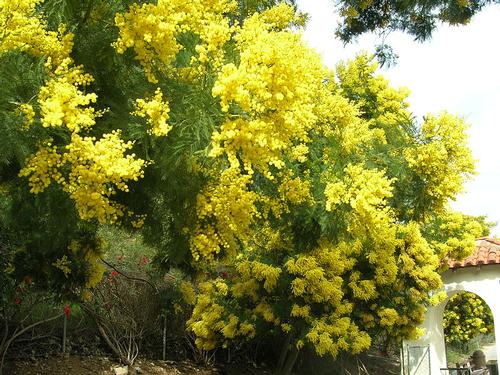 Acacia BrazilPhoto: J Brew CC 2.0 Generic no changes made
Acacia BrazilPhoto: J Brew CC 2.0 Generic no changes made
The white-gray drought forest (caatinga) of the northern mountain country consists of deciduous trees, palms, acacias, succulents, cactuses and thorn bushes. Special is a shrub with red loads, the flowers of which are only open at night.
South of this is a savanna landscape (campos) with gallery forests along the rivers. Grass prevails on the campos. Around the capital Brasília and the states of Goías and Mato Grosso do Sul, the "cerrado" is a savanna landscape with an impenetrable jumble of shrubs and trees. The Pantanal is comparable to the Amazon in terms of diversity of flora and fauna. In the always humid areas, many types of aquatic plants occur with beautiful water hyacinths on the banks and dikes.
The highlands of Southeast Brazil are partly covered with light forests (araucaria). The "matas dos pinhais" are pine forests that occur in the south of the country.
The Rio Grande do Sul state is predominantly subtropical forest.
Almost the entire coast, up to Santos, has a mangrove vegetation.
The area in use as a cultural land is largely confined to the coastal zone and inland to the states of São Paulo and Santa Catarina. The original vegetation has practically disappeared over time.
Over the past thirty years, according to estimates by the Brazilian government, more than 530,000 square meters have been lost through deforestation of the tropical rainforest in the Amazon that stretches across northern South America. As a contribution to global efforts to curb global warming, the country pledged last year at the Copenhagen climate summit to cut forest clearing by 80 percent by 2020.
Deforestation in the Amazon has fallen by 14 percent. Brazil expects to achieve the target of 80 percent well before the 2020 deadline.
Animals
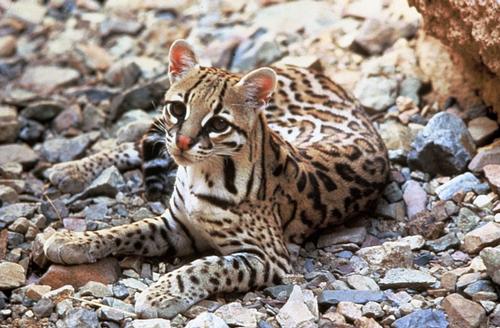 Ocelot BrazilPhoto: Tom Smylie in the public domain
Ocelot BrazilPhoto: Tom Smylie in the public domain
The animal world, especially that of the rainforest, is of a tropical variety of forms, although the really large herbivores as known from the Old World are missing. More trees, birds and insects live in the tops of the tropical rainforest than on the ground. Brazil ranks first in terms of the number of primate, amphibian and plant species; third in birds and fourth in butterflies and reptiles.
Broad-nosed monkeys, prehensile-tailed monkeys (howler monkeys, capuchin monkeys, spider monkeys, woolly monkeys live there, as well as claw monkeys (owl monkeys, spring monkeys, brush monkeys and squirrel monkeys), all real tree dwellers.
Feline predators include the jaguar, the cougar and the ocelot; the raccoons are represented by, among others, the crab eater, the roller-tailed bear and the nose bear. Of the dog-like predators, the bush dog and the mane wolf deserve mention. In the Amazon region you will also find the giant otter that can grow up to two meters long.
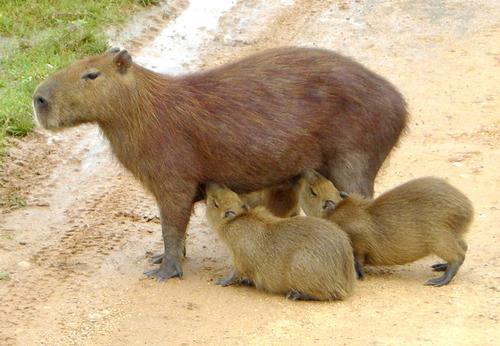 Capibara BrazilPhoto: Fidel León Darder CC 3.0 Unported no changes made
Capibara BrazilPhoto: Fidel León Darder CC 3.0 Unported no changes made
Large ungulates include the tapir and the swamp deer; the navel pigs also live here. The number of rodent species is large, including the agouti, the pekari swine, the capybara (largest rodent in the world; up to 45 kg) or water boar, the mock rats and the prehensile porcupines, in the south also the coypu.
Typical South American species are the armadillos, sloths and anteaters. Sea cows or manatees live along the coast, up to the Amazon, and freshwater dolphins live in the rivers, of which the pink variety is very special. On the Brazilian beaches, five more species of sea turtles lay their eggs every year: the sea turtle, the green turtle, the loggerhead turtle, the leatherback turtle and the common hybrid turtle. The coral Abrolhos archipelago is special, among other things, because of the humpback whales, which have their main breeding area here in the southwestern Atlantic.
The number of bat species is large. The possums have an important distribution here; this is also home to the water possum, the only aquatic marsupial.
The bird world is very rich in species and individuals; among them are many endemic genera. Noteworthy are the hummingbirds, the oven birds, the flycatchers, the ant birds, the parrots and the toucans. Special is the parrot island "Ilha dos Papagaios" which lies in the mouth of the Rio Guamá, directly opposite Belém, and where about 1300 parrots live. The largest eagle in the world, the harpy eagle, lives in the Amazon region.
The number of reptiles and amphibians is also large, including anacondas (up to 12 meters long), boa constrictors, coral snakes, lance-headed snakes, pit vipers and poisonous frogs.
The rivers are rich in catfish, carp salmon and cichlids and probably have the richest freshwater fish fauna in the world.
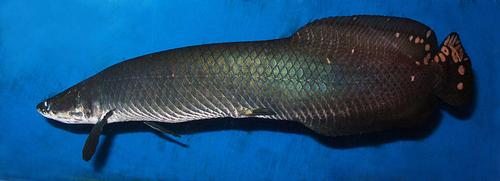 Arapaima BraziliePhoto: George Chernilevsky in the public domain
Arapaima BraziliePhoto: George Chernilevsky in the public domain
This includes the arapaima, the largest freshwater fish in the world with a length of 3 meters. Piranhas, electric eels and stingrays are dangerous. Special is the "tambaqui", which can crack nuts.
The shapes and colors of the insects, especially that of the hundreds of species of butterflies, are unimaginably great. About one third of the one million insect species we know are found in the Amazon, including parasol ants. Very large snails are also known from Brazil. The drier savanna areas have their own fauna.
The Pantanal, an area half the size of France in western Brazil, has a very diverse animal life, comparable to the Amazon region. For example, there are about 600 bird species. Impressive is the jabiru stork or tuiuiu and other striking birds are the magoari, a heron species, the blacka bigua, the brown bigua-tinga, the colhereiro, and the cardeal. Furthermore, many species of macaws, parakeets, hummingbirds, ibises, parrots, finches, herons, woodpeckers, and the hawk, falcon, kurlan, cardinal, water rail, kingfisher, cuckoo, thorn bird, shrike, wren, jay and blackbird.
Countless caimans (jacaré's) live along the banks of rivers and large snakes are also common, even more so than in the Amazon. The black caiman becomes very rare due to the many poachers who chase the animal's skin.
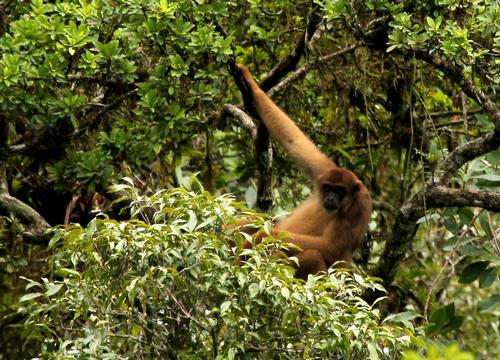 Wool spider monkey BrazilPhoto: Sinara Conessa CC 2.0 Unported no changes made
Wool spider monkey BrazilPhoto: Sinara Conessa CC 2.0 Unported no changes made
The Mata Atlântica features the unique "mariqui", a wool spider monkey, the largest monkey in both North and South America. Furthermore, the brown howler monkey, the marmoset and the golden lion monkey.
The greatest threat to the animal world is the destruction of the primeval forest, otherwise uncontrolled hunting and animal trade. Nature conservation is slowly gaining ground, which in many cases may be too late. The Itatíaia national park in the east includes a mountain massif. Experiments are currently being carried out with the release of protected claws or lion tamarins in protected places.
In June 2004, it was announced that Dutch scientist Marc van Roosmalen had discovered a new type of mammal, a navel boar. Until now, there have been three types of belly pigs; the animal described by the Dutchman differs in size and in drawing on its fur from those three other species.
In the Amazon rainforests, American scientists discovered a new monkey species in 2007. The Brazilian monkey is related to the saddleback tamarin, which are known for their variegated ridges. The little monkey weighs just over 200 grams and is named Mura's gable roof tamarin.
Sources
Bayer, M. / Brazilië
Gottmer/Becht
Bayer, M. / Brazilië : mensen, politiek, economie, cultuur
Koninklijk Instituut voor de Tropen/Novib
Bender, E. / Brazil
Chelsea House Publishers
Brazil
Apa Publications
Brazil
Lonely Planet
Brazilië
The Reader's Digest
Dekker, J. / Reishandboek Brazilië
Elmar
Heinrichs, A. / Brazil
Children's Press
CIA - World Factbook
BBC - Country Profiles
Copyright: Team The World of Info